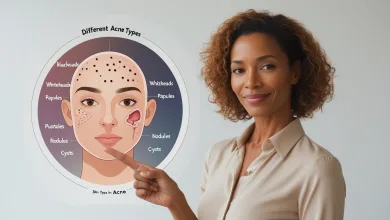Diet and Acne: Foods That Help and Foods That Hurt

The relationship between what you eat and those pesky pimples isn’t just an old wives’ tale. Science is increasingly confirming that certain foods can either trigger breakouts or help clear up your complexion. Let’s dive into the delicious (and not-so-delicious) truth about diet and acne.
The Diet-Acne Connection: More Than Just Chocolate Myths
You’ve probably heard it a million times growing up: “Stop eating chocolate or you’ll get pimples!” But is there any truth to the idea that diet affects your skin? Well, it turns out your grandma wasn’t completely off base—though the reality is way more nuanced than just avoiding your favorite candy bar.
Recent research has firmly established connections between what we eat and how our skin behaves. The old notion that diet and acne are unrelated has been thoroughly debunked. A 2021 review published in the International Journal of Dermatology analyzed multiple studies and concluded that dietary factors can significantly influence acne development and severity. It’s not just about one food or another—it’s about understanding how different foods affect your body’s hormones, inflammation levels, and oil production—all key players in the acne game.
Foods That Can Trigger Acne Breakouts
Let’s get down to business—which foods might be sabotaging your skin? Here’s the not-so-sweet truth about acne-triggering foods:
High-Glycemic Carbohydrates: The Sugar Saboteurs
That mid-afternoon pastry might be satisfying your sweet tooth, but it could also be fueling your breakouts. Foods with a high glycemic index cause rapid spikes in blood sugar and insulin levels, which can increase sebum production and promote inflammation—two major contributors to acne development.
A landmark study in the American Journal of Clinical Nutrition found that participants following a low-glycemic diet showed significant improvements in acne severity compared to those eating high-glycemic foods. So what exactly are these high-glycemic culprits? They include:
- White bread, bagels, and other refined grains
- Sugary cereals and breakfast foods
- Cakes, cookies, and pastries
- White potatoes and instant mashed potatoes
- Sodas and sweetened beverages
- Candy and other sugary snacks
Swapping these high-glycemic foods for complex carbohydrates like whole grains, legumes, and vegetables can help manage blood sugar levels and potentially reduce acne flare-ups.
Dairy Products: Milk’s Complicated Relationship With Skin
Got milk? You might also have acne. Numerous studies have linked dairy consumption—particularly milk—to increased acne prevalence and severity. A 2018 meta-analysis in Clinical Nutrition examined 14 studies and found a positive association between dairy intake and acne.
The acne-promoting effects of dairy likely stem from several factors:
- Growth hormones and bioactive molecules naturally present in milk
- Milk’s ability to stimulate insulin and IGF-1 (insulin-like growth factor 1), which promotes sebum production
- Whey and casein proteins that may influence hormonal balance
Interestingly, not all dairy affects skin equally. Skim milk shows stronger associations with acne than whole milk in some studies, and yogurt and cheese don’t seem to have the same strong connection—though research continues to evolve in this area.
Processed Foods and Fast Food: The Convenience Cost
That drive-thru burger might satisfy your hunger, but your skin could pay the price. Ultra-processed foods and typical Western fast food items combine multiple acne triggers: they’re often high in refined carbs, saturated fats, and contain numerous additives.
A 2020 study in JAMA Dermatology found that frequent consumption of fatty and sugary products was associated with current acne in adults. The combination of inflammatory fats, high glycemic load, and various food additives creates the perfect storm for skin problems.
Foods That May Help Fight Acne
Now for the good news! Some foods don’t just avoid triggering acne—they might actively help combat it. Here’s what to load up on:
Omega-3 Fatty Acids: Anti-Inflammatory Powerhouses
When it comes to fighting inflammation (a key contributor to acne), omega-3 fatty acids are your skin’s best friend. These beneficial fats, found in fatty fish, flaxseeds, and walnuts, help counteract the inflammatory response that can worsen acne.
A clinical trial published in Acta Dermato-Venereologica showed that participants taking omega-3 supplements experienced significant reductions in inflammatory and non-inflammatory acne lesion. While more research is needed, incorporating these sources of healthy fats into your diet makes sense:
- Fatty fish like salmon, mackerel, and sardines
- Walnuts and flaxseeds
- Chia seeds
- Fish oil supplements (consult with a healthcare provider first)
Aim for 2-3 servings of fatty fish per week or plant-based alternatives if you follow a vegetarian or vegan diet.
Antioxidant-Rich Fruits and Vegetables: Color Your Way to Clearer Skin
You’ve heard “eat the rainbow” as general health advice, but it applies to skin health too. Fruits and vegetables rich in antioxidants help fight oxidative stress and inflammation—two factors that can worsen acne.
Vitamin A (found in orange and yellow produce), vitamin E (in nuts and seeds), and vitamin C (in citrus and berries) are particularly beneficial for skin health. A 2020 cross-sectional study in Nutrients found that higher intake of fruits and vegetables was associated with lower odds of moderate-to-severe acne.
Don’t skimp on these skin-supporting superstars:
- Dark leafy greens (spinach, kale, collards)
- Orange vegetables (carrots, sweet potatoes, pumpkin)
- Berries (strawberries, blueberries, blackberries)
- Tomatoes
- Bell peppers
A good rule of thumb? Try to fill half your plate with fruits and vegetables at most meals.
Probiotics and Fermented Foods: Gut Health for Skin Health
The gut-skin axis is real, folks! Emerging research suggests that gut microbiome health may influence skin conditions, including acne. Probiotics and fermented foods can help balance gut bacteria and potentially improve skin health as a result.
A review in Dermatology Practical & Conceptual discussed how probiotics might help acne by reducing inflammation and oxidative stress. While definitive clinical trials are still needed, adding these probiotic-rich foods to your diet could be beneficial:
- Yogurt with live active cultures (if dairy doesn’t trigger your acne)
- Kefir
- Kimchi
- Sauerkraut
- Kombucha
- Tempeh
Just a serving or two daily may help support your gut microbiome and potentially your skin health.
The Role of Zinc and Other Nutrients in Acne Management
Let’s talk micronutrients! These tiny but mighty dietary components can make a big difference for your skin.
Zinc deserves special mention in the acne conversation. This essential mineral has anti-inflammatory and antibacterial properties and helps regulate oil production in the skin. Multiple studies have found that people with acne often have lower zinc levels than those without, and supplementation can improve symptoms in some cases.
Good dietary sources of zinc include:
- Oysters (the zinc superstar!)
- Red meat
- Poultry
- Beans and lentils
- Nuts and seeds
- Whole grains
Other nutrients that may benefit acne-prone skin include selenium, vitamin D, and vitamin E. Rather than focusing on supplements (which should only be taken under medical supervision), aim for a varied diet rich in whole foods to get the full spectrum of skin-supporting nutrients.
Hydration and Acne: Water as Your Skin’s Best Friend
We can’t talk about diet and skin without mentioning water! Proper hydration is crucial for overall skin health and may help with acne in several ways.
Adequate water intake helps your body flush out toxins, transport nutrients to skin cells, and maintain skin elasticity and resilience. While drinking water won’t directly “wash away” acne, dehydration can make your skin more vulnerable to irritation and slower to heal.
How much should you drink? While the “8 glasses a day” rule isn’t one-size-fits-all, aiming for pale yellow urine is a good indicator of proper hydration. Also remember that certain foods (particularly fruits and vegetables) contain water that contributes to your daily intake.
Beyond plain water, green tea deserves special mention for acne-prone individuals. It contains polyphenols with anti-inflammatory and antimicrobial properties that may benefit acne-prone skin when consumed regularly.
Creating a Skin-Friendly Diet Plan
Now that we’ve covered the foods that help and hurt acne-prone skin, how do you put this information into practice? Here’s a practical approach:
Start With a Food Journal
Before making dramatic dietary changes, try keeping a food diary for 2-4 weeks. Note what you eat and drink alongside observations about your skin condition. This personal data can reveal patterns between specific foods and breakouts that might not apply to everyone.
Don’t expect overnight results! The skin cell turnover cycle takes about 28 days, so give your dietary changes at least a month before judging their effectiveness.
Focus on Addition, Not Just Elimination
Instead of just cutting out potential trigger foods (which can lead to nutritional deficiencies and an unhealthy relationship with food), focus on adding skin-supporting foods to your diet:
- Add a serving of fatty fish weekly
- Incorporate more colorful fruits and vegetables daily
- Try including small amounts of fermented foods
- Ensure adequate protein from quality sources
- Choose whole grains over refined carbohydrates
This positive approach makes dietary changes more sustainable and enjoyable.
Individualized Approaches: Why There’s No One-Size-Fits-All Solution
Here’s the truth that dermatologists and nutritionists alike will tell you: acne triggers can vary significantly from person to person. While research identifies common culprits, your unique genetic makeup, hormonal balance, and gut microbiome influence how your skin responds to different foods.
This individual variation explains why your friend might break out from dairy while you can enjoy cheese without consequences, or why you notice flare-ups after eating certain foods that don’t bother others.
Dr. Jennifer Burris, nutrition researcher at New York University, notes in her research: “The relationship between diet and acne is highly individualized, and the impact of particular foods should be considered on a case-by-case basis”.
When to Seek Professional Help
While dietary changes can support clearer skin, they’re not always sufficient on their own—especially for moderate to severe acne. Consider consulting with:
- A dermatologist if your acne is persistent, painful, or causing scarring
- A registered dietitian if you’re considering major dietary changes or struggling to identify trigger foods
- An endocrinologist if hormonal issues might be contributing to your acne
Remember that comprehensive acne treatment often combines proper skincare, possibly medication, stress management, AND dietary considerations.
Frequently Asked Questions About Diet and Acne
Does chocolate really cause acne?
It’s complicated! Dark chocolate in moderation likely won’t cause problems for most people. However, milk chocolate and chocolate with high sugar content combine dairy and high-glycemic ingredients that may trigger breakouts in sensitive individuals. A small study in The Journal of Clinical and Aesthetic Dermatology found that consuming 100% cocoa increased acne lesions in acne-prone males, suggesting that even cocoa itself might influence acne in some people.
How long after changing my diet will I see improvements in my skin?
Patience is key! Since skin cell turnover takes approximately 28 days, give dietary changes at least 4-6 weeks before evaluating their impact. Some people notice improvements sooner, while others may need 2-3 months to see significant change.
Are there specific diets recommended for acne control?
While no single “acne diet” works for everyone, several dietary patterns show promise:
- Low-glycemic diet (focusing on complex carbs and limiting refined sugars)
- Mediterranean diet (rich in anti-inflammatory foods and healthy fats)
- DASH diet (emphasizes fruits, vegetables, and whole grains)
The common thread? All minimize processed foods and emphasize whole, nutrient-dense options.
Can supplements help clear acne?
Some supplements show promise for acne management, including zinc, omega-3 fatty acids, and certain probiotics. However, supplements should be taken with caution and ideally under healthcare supervision, as they can interact with medications and have side effects. Always try to get nutrients from food sources first.
Final Thoughts: Balancing Diet and Acne Management
The connection between diet and acne is real, but it’s just one piece of a complex puzzle. While certain foods may trigger or improve breakouts, focusing exclusively on diet while ignoring other factors—like stress, sleep, hormones, and proper skincare—won’t yield optimal results.
That said, making thoughtful dietary choices represents one of the most accessible ways to support your skin health from within. Rather than viewing certain foods as “forbidden,” think of your dietary choices as tools that empower you to influence your skin’s appearance and health.
Remember too that perfect skin shouldn’t come at the expense of your overall wellbeing or relationship with food. Sustainable dietary changes that support both skin health AND overall health are the ideal approach. After all, truly radiant skin reflects overall health and vitality—not just the absence of acne.
By understanding how different foods interact with your unique body, you can make informed choices that help you look and feel your best. Here’s to clearer skin and healthier eating, one bite at a time!






